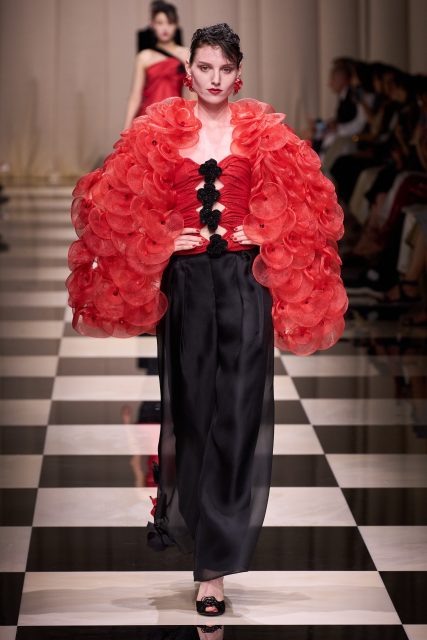“Making clothes is my armor.” At the end of the Balenciaga haute couture show, Eliza Douglas, walking in a shining, chrome-laminated 3D printed bell-skirted suit of armor, reminded Demna of Joan of Arc—and also of himself. “Maybe she wouldn’t have been burned at the stake for wearing men’s clothes if she was wearing that,” he remarked. “Because all my life I suffered because of what I wear.”
Demna wasn’t in a dour mood at all as he speed-extemporized these thoughts in the quick post-show debrief to journalists. Whatever inferences to embattlement, self-protection and resilience might have been fleetingly caught in that conversation, his main point was that being immersed in making clothes is his happiest place. “Couture to me is specifically about clothes. There was a narrative that somehow happened by itself. It was kind of making a bridge between the past and now, which is the reason I wanted to do it from the beginning.”
So: back to the beginning of that “bridge.” Demna opened the show with a replica black velvet Cristóbal Balenciaga haute couture dress. It was worn by the exquisitely elegant Danielle Slavik, who originally modeled it for Balenciaga himself. Grace Kelly ordered it, with its integral pearl necklace, for her 40th birthday. Slavik had told Demna that it was her favorite dress ever.
His to and from between tradition and innovation began with his own fascination with tailoring. For a start, he probed the structure of tailoring for day. He who shot to fashion fame by making jacket shoulders humongous now made them disappear altogether, cutting wide funneled necklines into narrow women’s coats and jackets. That idea, he said, had come from turning jackets upside down. In one way, it read as a couture elevation of the suiting inversions he’d started in ready-to-wear. In another, it was surely a nod to the founder’s signature obsession with sculpting dresses to frame the beauty of his clients’ faces.
Menswear occupied an extensive section of the collection. It took in ultra-rigorous black-tie formality and normal-seeming business suits, right through to couture treatments of all the casual generics Demna’s been known for since day one. Menswear traditionally played no part in haute couture, it should be remembered.
Silhouette-wise, with his extended-toe shoes poking out from trousers and jeans, it all appeared to be not so different from Demna’s signature ready-to-wear. In fact, he said, a slew of hidden trompe l’oeil handcrafted techniques had been lavished on oil painting fabric to imitate fur, printing Japanese denim to mimic Prince of Wales check, and ‘windswept’ raincoats and mufflers sculpted to look as if they were caught in a storm. “Because I like the couture that you see, and I like the couture that you don’t see,” he said. “What’s really important is the techniques that maybe aren’t so visible. That’s a big part of who I am, and who Cristóbal Balenciaga was, too. So I wanted that balance. Couture shouldn’t always be in your face, and like ‘this is a gorgeous dress.’”
But there were gorgeous dresses, too. Isabelle Huppert came out in a heavily-pailletted full-skirted black dress like some gothic Infanta. There were others which, again, looked as if they’d been caught in movement; a taffeta neckline dramatically blown to one side, a slick black twist of a thing spiraled around the body.
Some of it had been made in a complicity between advanced technology and the human hand. A red lace dress became a stiff, bell-shaped filigree. The warrior in shining silver armor, of course. All this is just as costly as anything traditionally ‘haute couture,’ of course—whilst being super publicity generating. Which is of course, very Demna, too.
Editor
Sarah MowerCredit
Lead Image: Courtesy of Balenciaga

